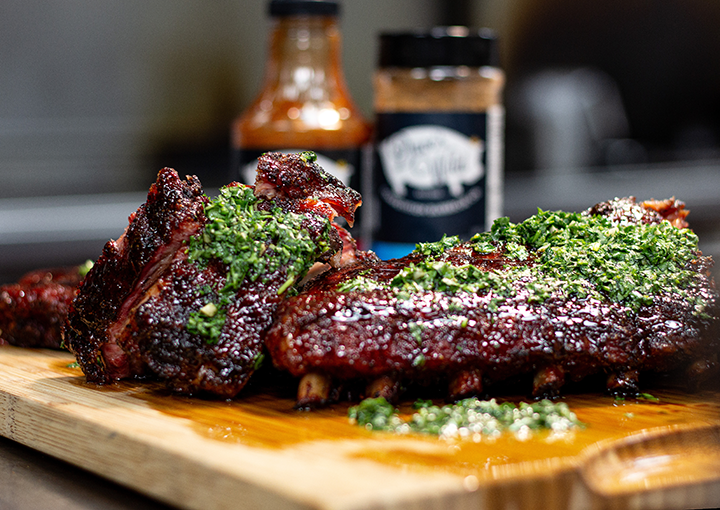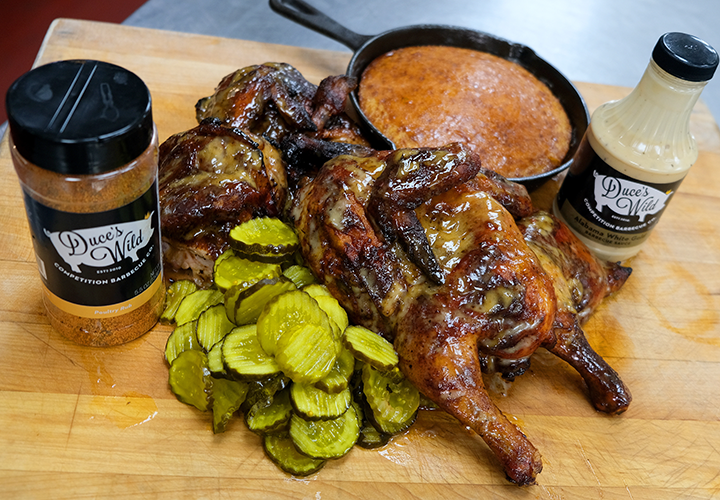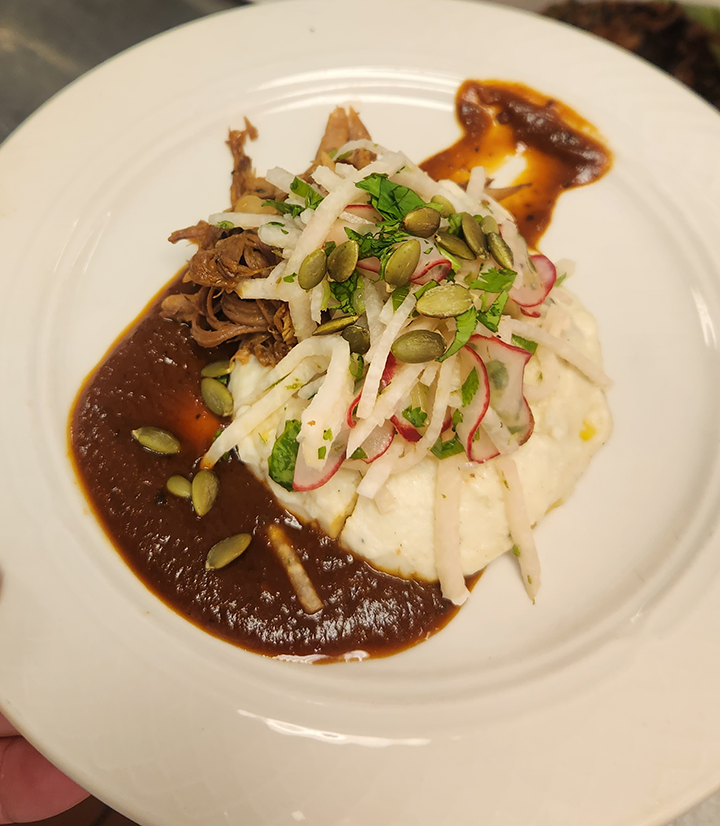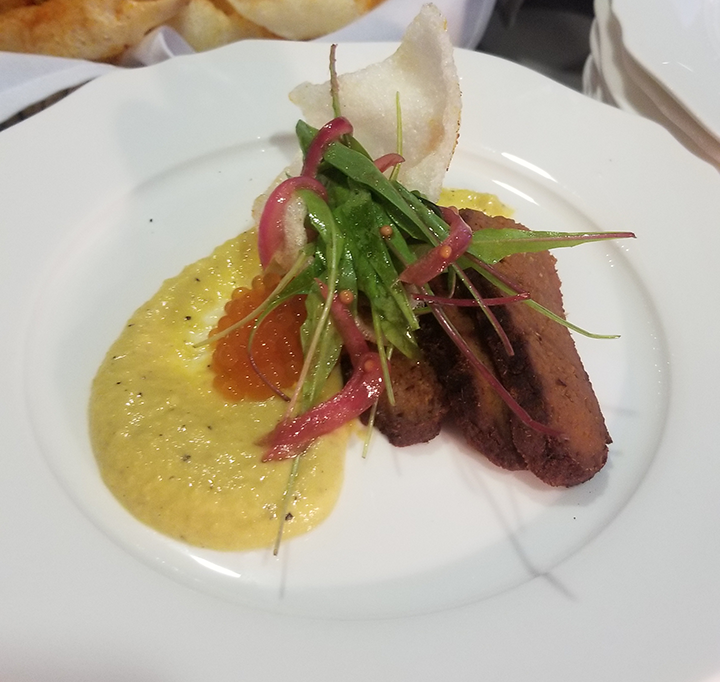Barbecue has long been quintessential American fare. From ribs to briskets, there’s just something about it that can’t be replicated.
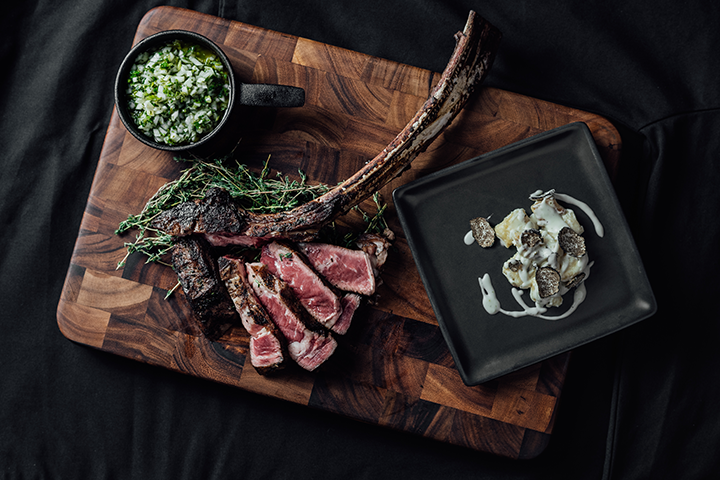
Dry-aged tomahawk steak with homemade malfatti pasta in a creamy truffle sauce. Photo courtesy Culinary Crafts
“The popularity of barbecue can be linked to a great combination of attributes. Barbecue has depth with its intensity of flavor, it solicits feelings of nostalgia, and it is an example of many food traditions that often include the fellowship of large groups of people,” says Patrick Wagner, Culinary Institute of the Carolinas at Greenville Tech (South Carolina).
Now, barbecue may not scream “elegance” when associated with a wedding or other catered event, but it has moved beyond its roots of backyard cookouts. Caterers are now discovering the secret to mastering the art of smoke and fire. From corporate events and weddings to outdoor festivals and family reunions, barbecue is a crowd-pleaser that can turn any gathering into a memorable experience.
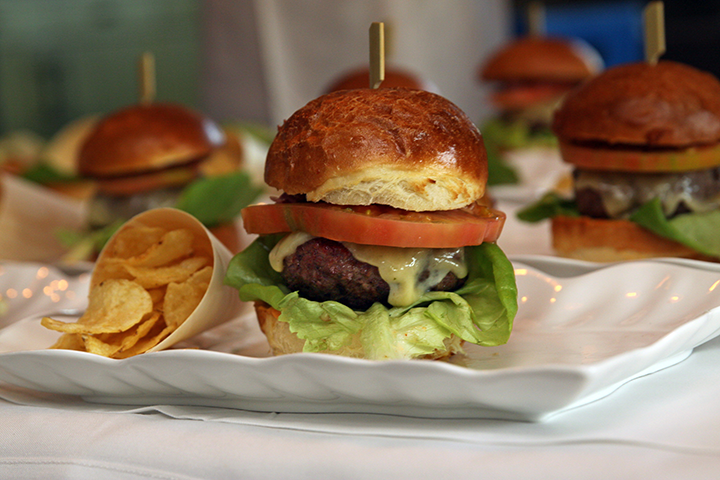
Culinary Crafts' "Scenic Route" Burger (house-made brioche bun toasted and brushed with butter, an heirloom tomato and crisp leaf of butter lettuce, a thick slice of local Beehive cheese, house-made chocolate ketchup and garlic aioli, and a hand-shaped patty made with a special blend of custom spices and grilled over a mesquite charcoal grill). Photo courtesy Culinary Crafts
“People tend to underestimate the art of barbecue,” said Einwav Gefen, Corporate Executive Chef for Unilever Food Solutions in a video for the Culinary Institute of America. “Barbecue, like many other things in food and in cooking, is a matter of perception.”
Slow and steady wins the race
There’s a common misconception among consumers that grilling and barbecue are interchangeable, but in reality they are actually quite different. In a nutshell, barbecue requires smoke to properly flavor and color the food. So basically, grilling means to cook over a fire, hot and fast. Barbecuing refers to cooking at low temperatures for extended time.
“Low and slow is key to most great barbecue for sure,” says Duce Raymond with SBR Events Group out of Illinois (and Catersource + The Special Event 2024 speaker!). “Besides quality meat, the best advice I can give to people about barbecue is to learn how to get a consistent temperature; this comes with experience, so the more you do it the better you will get.”
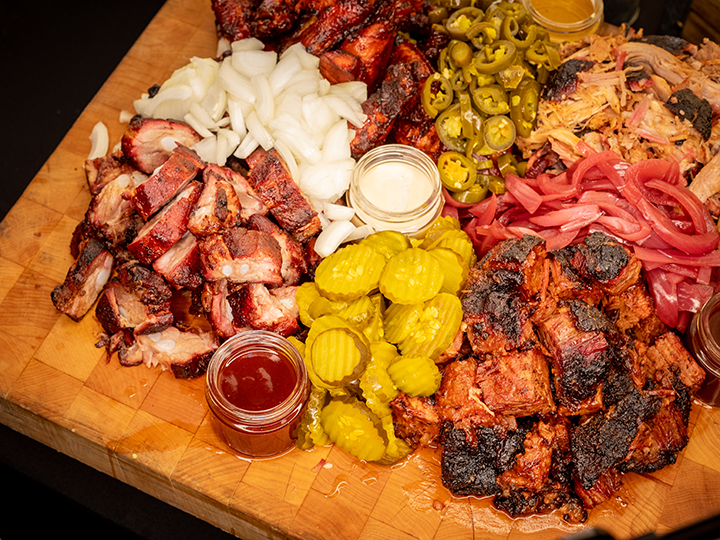
A Super Bowl barbecue platter from SBR Events Group. Photo courtesy Duce Raymond
What Wood You Do?
One of the most important ingredients to any great barbecue is the wood, and what wood you use will have an impact on the flavor and the finished product.
Obviously personal preference plays a role, but here are some of the most common types of hardwoods and their characteristics.
Applewood
Light, fruity, slightly sweet aroma with a mild and sweet flavor
Best for: pork and poultryAlmond
Burns clean and does not leave a lot of ash
Best for: pizzaCherrywood
Imparts a fruity and slightly sweet taste
Best for: beef, pork, poultry, and salmonOak
Offers a robust and smoky flavor, stronger than apple and cherry but lighter than hickory
Best for: red meats (beef and lamb) and pizzaPecan
Mild wood that has a sweet flavor, sometimes even described as spicy or nutty
Best for: ribs, fish, beef, and poultryHickory
Savory (often closely related to the richness of bacon) with a stronger flavor than oak that adds a dark color to smoked meat
Best for: Beef and porkMesquite
A strong and bold flavor
Best for: steaks and brisketsMaple
A light sweet aroma
Best for: "delicate cooks" like vegetables, cheese, and chicken or poultryPeach
A mild sweet, fruity smoke
Best for: beef, pork, and poultryInformation above courtesy:
Beyond that, controversy reigns.
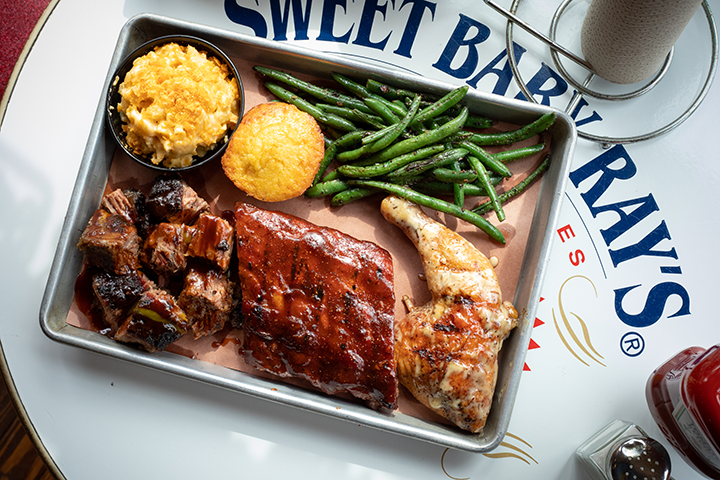
A combo platter from SBR Events Group. Photo courtesy Duce Raymond
“Barbecue is life for a lot of people,” said Bill Twaler, former chef at Truist Culinary and Hospitality Innovation Center (CHI) at Greenville Technical College, in a ChefsForum video for the American Culinary Federation titled Modern BBQ Techniques. “Don’t ever ask someone what their favorite barbecue is; those are fighting words in the South.”
Fiercely passionate
Chicago and New York have their pizza war, but perhaps no other food in the South evokes such passionate opinions as barbecue. It’s one of those foods that can make you instant friends or enemies depending on sauce preference and meat preference.
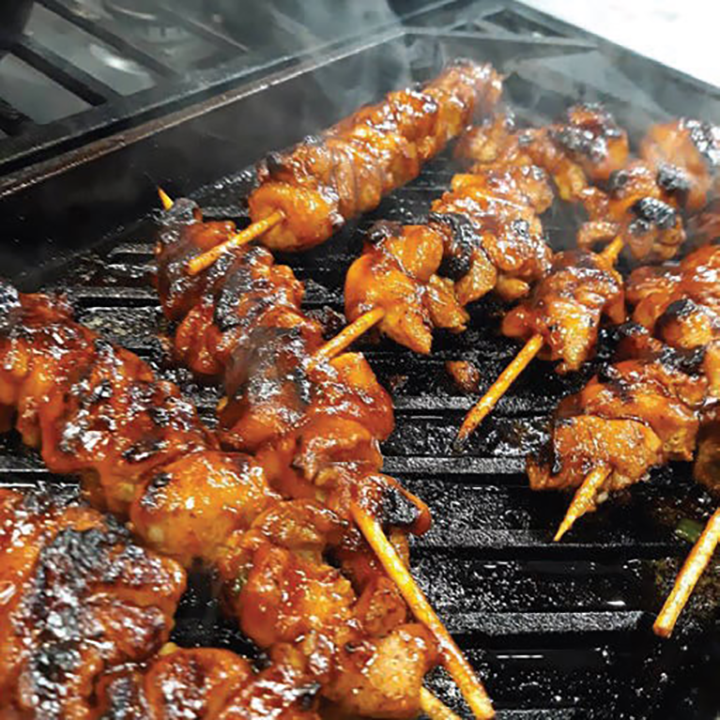
Barbecued Coca-Cola chicken skewers from Chef Jennifer Hill Booker (National Culinary Review). Photo courtesy American Culinary Federation
Barbecue isn’t just a style of cuisine; it’s also about tradition, cultural identity, and in many cases, closely guarded secrets.
“We have a taste for what we have grown up with, we are proud of our traditions, and weekend pit masters often invest lots of pride, time, and effort into their barbecue,” says Wagner.
This passion for barbecue is presumably the catalyst for the high number of barbecue competitions that put the skill and expertise of barbecue masters on display.
“I think it comes down to people being proud of where they come from,” says Raymond. “Certain locations, specifically the South, do things in a specific way and that is what they know as barbecue.”
Regional tastes
Barbecue differs greatly from region to region (hence the fierce regional rivalries). Some believe that pork is the only real barbecue, but beef, mutton, and even goat (kid) are traditional choices for others. Some argue in favor of a thick, tomato-based sauce, others for a thin, vinegar-based sauce. Some prefer hickory for fuel, while others tend toward pecan, maple, or oak.
“There should be respect and truth in regional barbecue,” says Wagner.
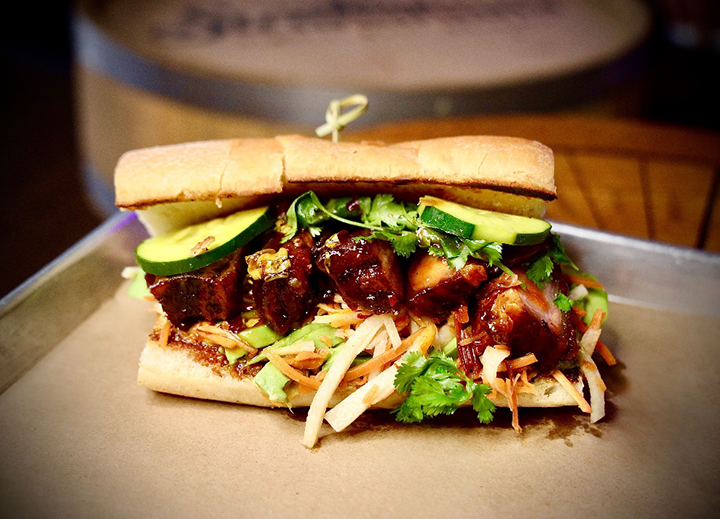
Pork Belly Bahn Mi. Photo courtesy Barrel & Bones
Here’s a breakdown of some of the most popular regional barbecue styles (according to Delish):
Central Texas
Central Texas is considered by many to be the epicenter of barbecue culture thanks to Lockhart (which neighbors the Catersource + The Special Event 2024 locale of Austin) holding the distinguished title of “The Barbecue Capital of Texas.”
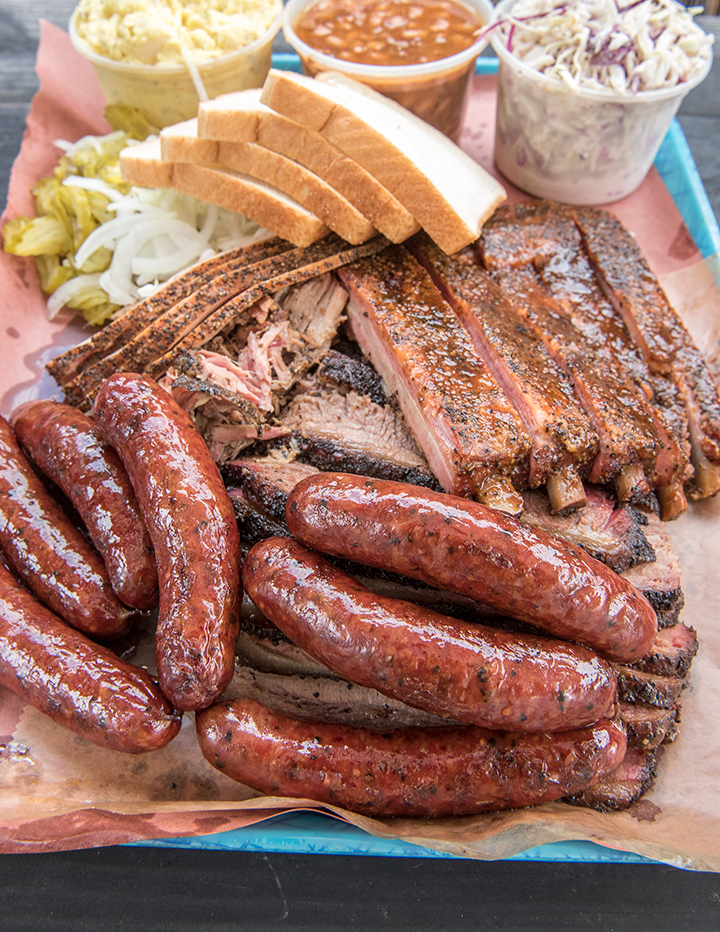
ames Beard-award winning pit master Aaron Franklin (Franklin Barbecue) is one of the most highly-regarded barbecue chefs in the world. Photo courtesy Wyatt McSpadden
Central Texas is all about dry rub (smoked brisket, pork ribs, and hot gut sausages) smoked over mesquite, pecan, or oak wood.
East Texas
In East Texas, you can almost guarantee the meat will fall off the bone. The famous chopped pork and beef sandwiches are marinated in a tomato-based sauce and usually smoked over hickory wood.
South Texas
Because of the nearby Mexican border, you'll find a lot of Tex-Mex barbecue here, including barbacoa and molasses-based barbecue sauces.
West Texas
Unlike the rest of Texas, in the west part of the state, they cook over direct heat with mesquite wood, so it's more like traditional grilling than it is to smoking.
North Carolina
Most known for whole pig on the smoker in a vinegar-based barbecue sauce.
South Carolina
South Carolina is all about pork. The sauces differ by region: in the northern regions of the state you'll find a light tomato; the west is heavy tomato; the south and central is mustard; and the east is a vinegar-pepper sauce.
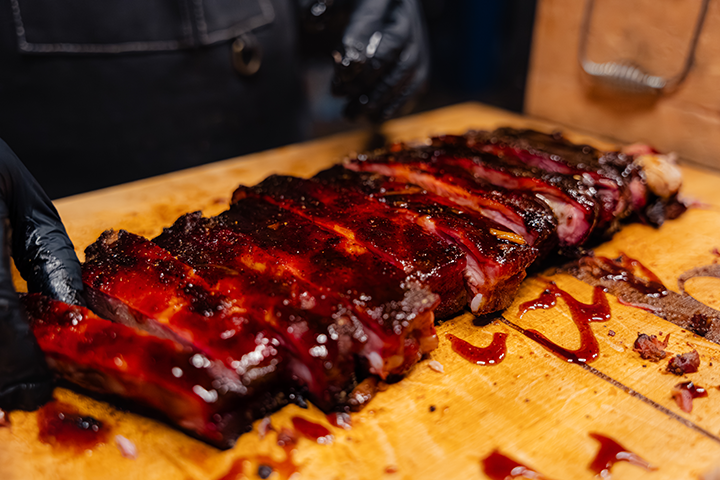
Smoked short ribs in a plum sauce served during M(Eat) Carnival. Photo courtesy Bryan Ngo
Kansas City
Kansas City is all about its burnt ends that have been hickory-smoked and smothered in a thick, sweet tomato-based barbecue sauce.
Memphis
Memphis is known for loving pork—ribs, pulled, and shoulder. It may be rubbed with spices like paprika and garlic in a "dry" fashion. If it's prepared "wet," however, it'll be continuously brushed with a sauce while being smoked. Marinades and bastes usually consist of apple cider vinegar, spices, apple cider, and even Coca-Cola or beer.
St. Louis
St. Louis–style barbecue is faster than other styles because it does not require smoking the meat for hours or applying a dry rub. St. Louis barbecue sauce is tomato-based, sweet, and vinegary. It traditionally contains ketchup, brown sugar, apple cider vinegar, salt, pepper, and other spices.
Alabama
Alabama barbecue is identified by pork, chopped or sliced, served on a hamburger bun with coleslaw and dill pickles. In the north, you'll find vinegar-based sauces, while all around the state, you'll find a white barbecue sauce of mayo, vinegar, lemon juice, black pepper, and salt smothering all the meat.
Kentucky
Kentucky is most known for mutton that has been sliced thin and topped with dips made of Worcestershire or vinegar and cayenne.
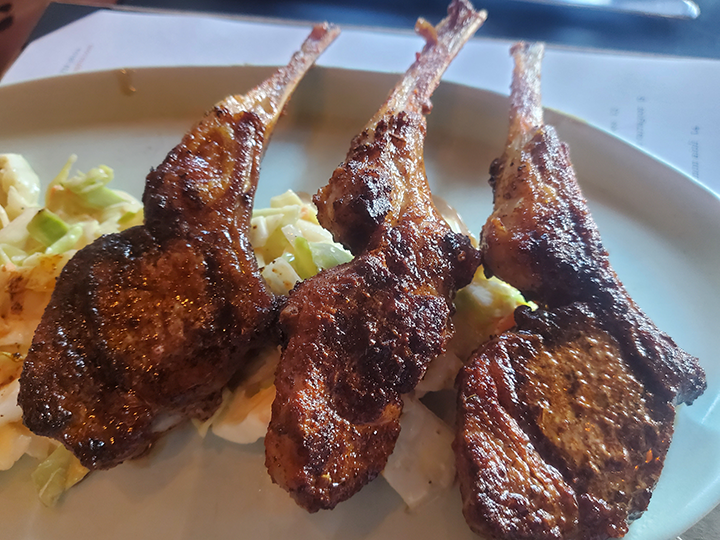
Barbecued lamb from Panta in Memphis. Photo courtesy Amber Kispert
Virginia
Any barbecue spot you go to in Virginia will likely have pork on the menu. But what's more important is the sauce. Each region has its own type: Northern Virginia is known for sweeter tomato-based sauces sometimes incorporating fruit; Central Virginia has sweet and sour sauces; and in Southern Virginia you'll find tomato- and vinegar-based sauces with mustard. And then you have the Shenandoah Valley, which is famous for barbecue chicken with an apple cider vinegar-based sauce.
The building blocks of barbecue
The first step in creating great barbecue is selecting the right cuts of meat. Some of the most popular are beef brisket, pork butts, tri-tip, plate-cut beef ribs, pork bone-in shoulder, baby back ribs, St. Louis ribs, and half chicken or chicken pieces.
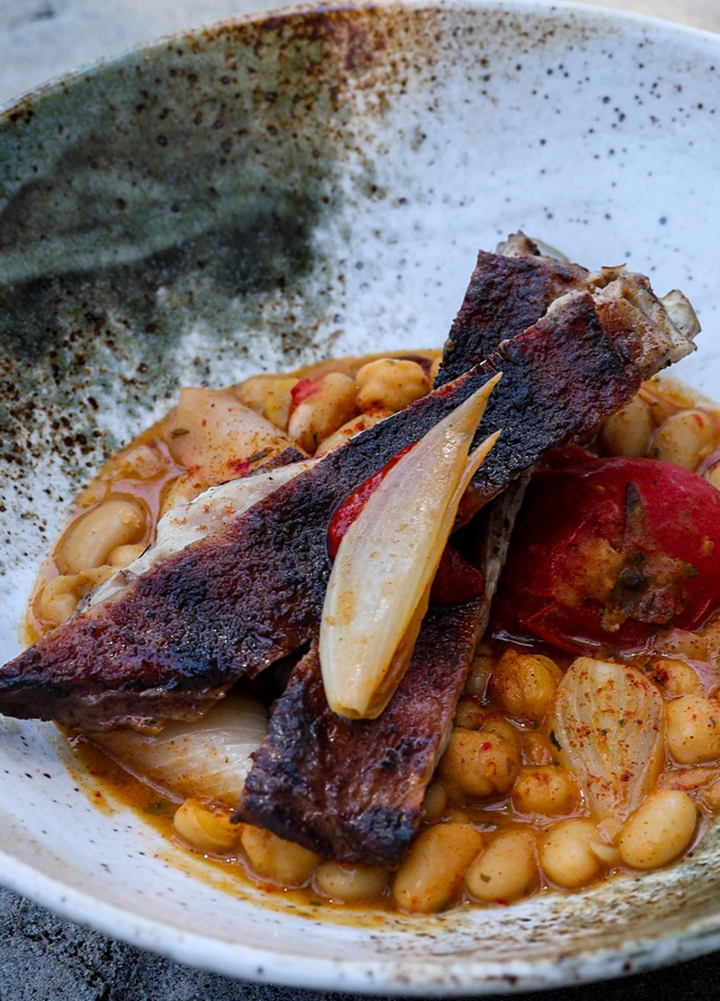
Moroccan Tan Tan Dry Rubbed Smoked Lamb Ribs with white beans, chick peas, lardo melted spring onions, Early Girl tomatoes, flamingo peppers, and coconut milk. Photo courtesy Deanna Sandoval
“The first thing I usually tell people is to start with good meat,” says Raymond. “There is a wide variety of options, but if you start with high quality, you will get something high quality when you are done.”
International Barbecue Styles
While the United States has very different opinions on what constitutes “barbecue,” it also begs the question of how does the rest of the world approach barbecue? Here’s a look:
- Korean barbecue: Korean barbecue, or gogi-gul, is a process of grilling meat over a charcoal or gas grill built right into the tabletop.
- Indian tandoori: Prepared using a clay or metal pot containing a charcoal or wood fire where the meat gets set as close to the flame as possible.
- Japanese yakitori: Yakitori is a popular barbecue street food in Japan. It consists of chicken skewered on bamboo or metal and grilled over charcoal. The grill itself is thin enough to hold the skewers above the coals and long enough to cook plenty at a time.
- Brazilian churrasco: Churrascaria cuisine is typically served rodízio style, where roving waiters serve the barbecued meats from large skewers directly onto the seated diners' plates.
- Mongolian barbecue: Mongolian barbecue is a stir-fried meal great for parties. It's called Meng Gu Kao Rou in Chinese. Each person can choose different types of meats and vegetables, which are then cooked on large solid iron griddles at a very high temperature.
- Turkish kebab: The Mediterranean diet is often cited as one of the healthiest on earth, so it’s no wonder that Mediterranean barbecue culture routinely incorporates vegetables. Turkish shish kebabs, or şiş kepap in the native language, are skewered chunks of meat, commonly lamb, as well as vegetables, simply cooked on an open grill or mangal.
- Filipino Lechon: Filipino Lechon follows the process of spit-roasting a whole pig over an open flame. Community plays a part here as well, especially since the process is long and labor-intensive; it begs for a party or special occasion. Hawaiian luau and Tahitian hima’a are similar activities that incorporate a whole-cooked pig into a celebration or ceremony.
- Hawaiian kālua: The word kālua translates as 'to cook underground'. This method of cooking is still used by some today. The traditional method required digging a dirt pit called an imu and cooking the pig in it with koa wood, lava rocks, and banana leaves.
Information above courtesy Institute of Culinary Education
However, access to high quality meat isn’t necessarily a deal breaker when it comes to barbecue.
“Barbecue allows you to overcome less premium cuts with the slow and low cooking," says Wagner. “The cuts you choose should reflect your customer’s budget and your intended use.”
The next key ingredient to great barbecue is the rub.
“Many of the best barbecue starts with the king and queen of cooking (salt and pepper),” says Wagner. “This is the foundation of your flavors, and you can build this into any final flavor if you keep it simple.”
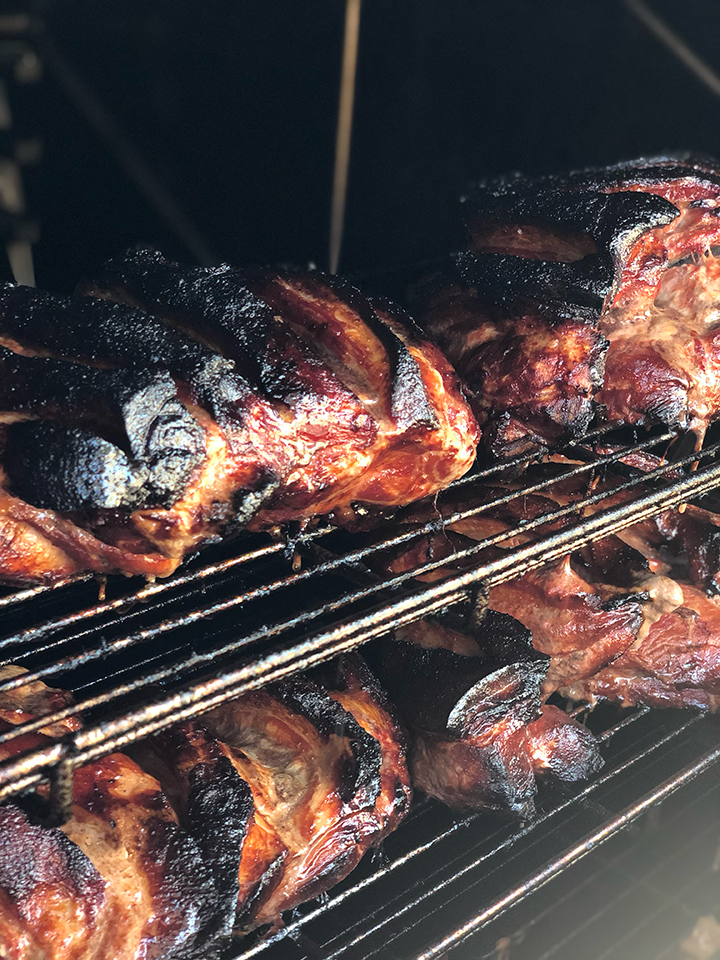
Brined and hickory smoked pork butts. Photo courtesy Tastebuds Custom Catering
However, barbecue rubs also offer an opportunity for experimentation.
“Traditional barbecue is simple and you cannot argue with that. Some of the best barbecue I have ever had was as simple as seasoning the meat with salt, pepper, and smoke,” says Raymond. “Modern barbecue on the other hand has so much room to grow. There are endless combinations.
"I enjoy using traditional techniques and applying different flavor profiles paired with unique presentations. For an Asian flavor profile, you may want to add ginger or Chinese Five Spice. If you are looking for a Central American flavor, you may want to check out some cumin, coriander, and oregano. This is the wonderful thing about barbecue; you can customize it to what you are looking for.”
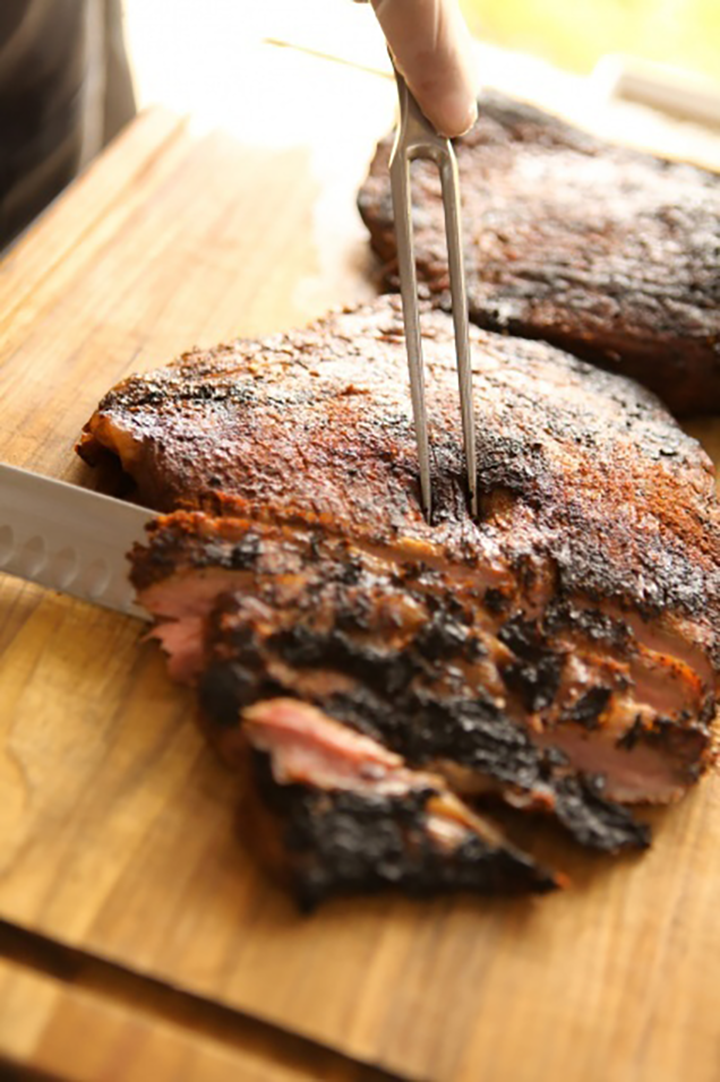
Mesquite grilled ancho rubbed wagyu flank steak. Photo courtesy Culinary Crafts
Given the amount of time barbecue requires, it may seem difficult to replicate in a catering environment.
“Take it slow,” says Wagner. “This isn’t something you can micromanage or rush to success.
“Barbecue is actually deceptively simple since it isn’t often improved by intensive hands-on cooking.”
However, there are a few shortcuts that caterers can take to achieve the same effect as the barbecue joints that smoke their meats for days at a time.
“The preparation has to be logistically sound to do large groups," says Greg Shapiro with Tastebuds Custom Catering (Florida). “The old technique of sitting by the fire or sitting by your smoker and smoking the meat for hours on end from a labor standpoint or logistically is just not feasible in the catering world, so you have to change those preparations and adapt them.”
One option is to smoke your meat (offsite) and then bring it up to temp on the grill during the event.
"That way you can still bring in that flavor profile,” says Keith Lord with Strateje Fourteen (California). “Obviously we would all love to pull a brisket out of a smoker and slice it, but that's not practical in catering.”
Another option is to incorporate the use of sous vide, either to reheat a pre-smoked meat (that has been blast chilled and vacuum sealed) onsite or to do a full preparation in the sous vide and simply "kiss” the meat on the grill and/or smoker.
“It is a very practical way of executing,” says Shapiro (who will be co-presenting a barbecue session with Lord during Catersource + The Special Event 2024). “It's extremely popular and logistically it's amazing because you’re only bringing a sous vide circulator and a water bathtub and you're not hauling a big smoker or an oven.”
The supporting players
While the meat takes center stage with barbecue, a well-rounded barbecue catering menu also includes a variety of mouthwatering sides and delectable sauces. From classic mac and cheese and tangy coleslaw to unique creations like barbecue baked beans and cornbread, these sides add depth and variety to the meal.
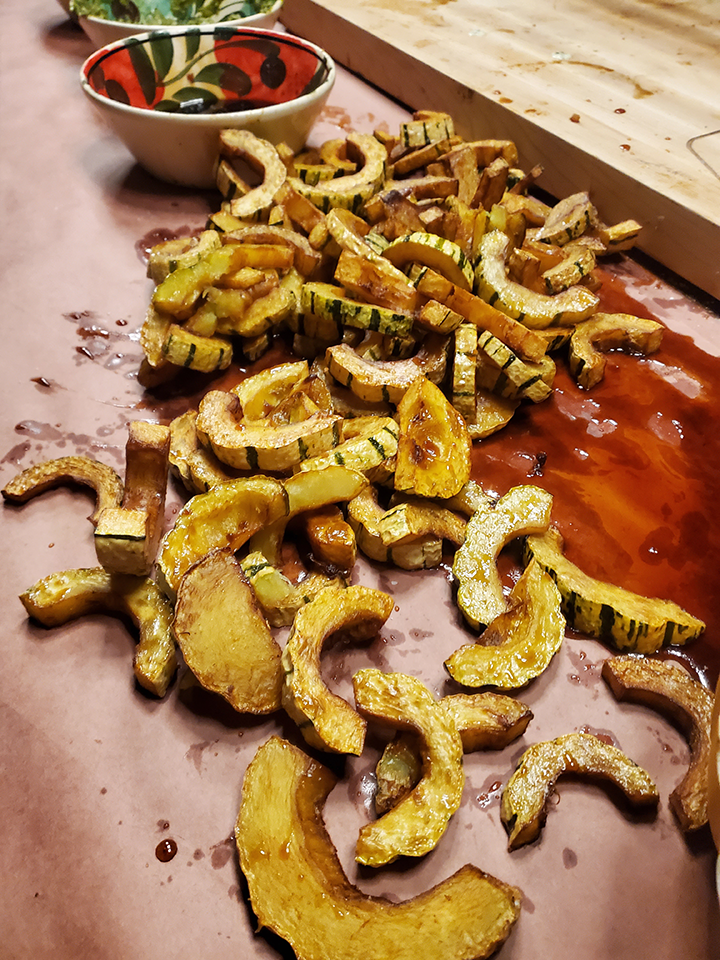
However, this is also an opportunity to elevate barbecue through unconventional accompaniments.
“This is your chance to elevate it with either a sauce or something you already have in your background, something that you already have that you use that's really successful,” says Shapiro.
“You have to follow your gut. When it comes down to it, if you've got something that's rich and fatty, then you're going to want to cut it with some acid. Go back to the building blocks of what you would use traditionally—are we talking about citrus or are we talking about vinegar? Are we looking to bolster the smokiness or are we looking to cut the richness?”
Lord agrees.
“It’s really about pairing up,” he says. “I think it opens up a new world here.”
Plant-based barbecue (such as jackfruit or smoked spaghetti squash) is also trending.
“Plant based is great because it offers the same excitement that meat barbecue fans love,” says Wagner.
Barbecue is obviously right at home at a rustic-style wedding or ranch event, but it may seem out of place at a black-tie affair, which is where creativity comes into play.
“Barbecue is delicious and flavorful, but as a main item it doesn’t demand the same money as it would if we use the bold flavors in other items,” says Wagner.
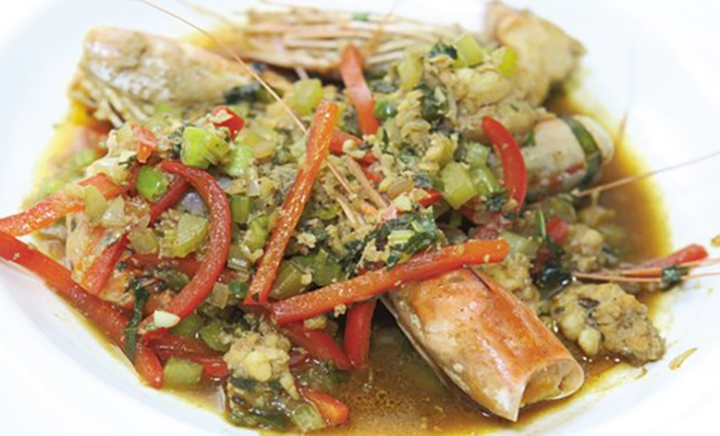
Cajun Barbecue Shrimp from the National Culinary Review. Photo courtesy American Culinary Federation
For example, barbecue can be a simple replacement for other meats in such elevated dishes as bao buns, tacos, pizza, sliders, or even a smoked brisket congee.
“You can bring it up a notch," Lord says. “Are you going to serve a beef rib on a plate for dinner? No. But you can get that same sort of essence of that flavor and that fat. It still has that same essence, that same smoke flavor, but I have manipulated it to a different palate.”
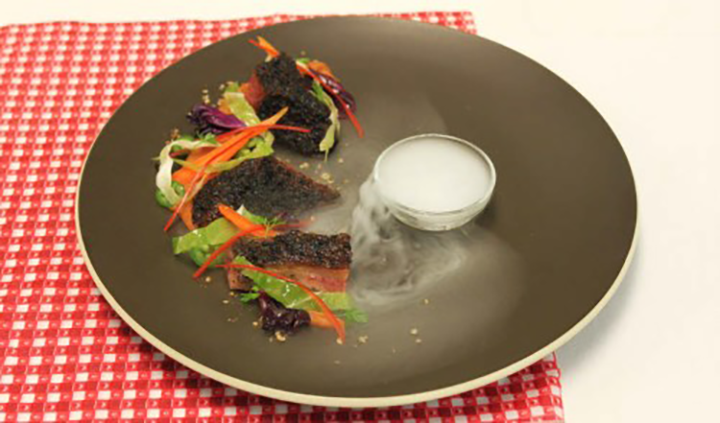
Brisket & Smoke (pinto beans puree, brisket, and Texas slaw). Photo courtesy American Culinary Federation
Barbecue is also a great option for a carving or action station.
“In catering, you can use the barbecue meat itself as a building block,” Shapiro says. “That’s what makes it cross over from what people expect, like a pulled pork sandwich wrapped in paper, to a white tablecloth center of plate type dish.”
Bon appetit!
Come & Get It!
Catersource + The Special Event will be talking all things barbecue in Austin, TX (February 12–15) during the following sessions:
- Texas Barbecue - The Strateje Fourteen Way - Sides, Sauces & Sweets
- Barbecue Elevated! Taking Barbecue to the Next Level
- Fanning the Flames: A Culinary Journey into the Art of Fire Cooking
Save your spot now at https://informaconnect.com/catersource-thespecialevent/
Duce's South American Pork Ribs with a Brazilian Twist & Spiced Agave Glaze
Recipe and image courtesy Duce Raymond, SBR Events Group
Ingredients for the Ribs
2 ea. racks of baby back ribs
Ingredients for the Rub
Ingredients for the Spiced Agave Glaze
Ingredients for the Homemade Chimichurri
Method
-
Prep the Ribs: Remove the membrane from the back of the ribs to allow better penetration of flavors.
-
Prepare the Rub: In a bowl, combine Duce's Wild Texas Rub, paprika, cumin, coriander, and oregano.
-
Season the Ribs: Generously coat both sides of the ribs with the prepared rub.
-
Smoke the Ribs: Preheat your smoker to 250°F (65°C). Place the ribs in the smoker and cook for about three hours, or until they are tender to your liking.
-
Prepare the Spiced Agave Glaze: In a saucepan, combine the agave nectar, Duce's Wild Competition Sauce, apple cider vinegar, cumin, and paprika. Simmer until it reaches a glaze-like consistency.
-
Finish on the Grill: Preheat your grill to medium-high heat. Remove the ribs from the smoker and place them on the grill. Brush generously with the spiced agave glaze and grill for 10-15 minutes, turning occasionally to prevent burning and to allow the glaze to caramelize.
-
Prepare the chimichurri: In a bowl, combine the finely chopped cilantro, parsley, minced garlic, olive oil, red wine vinegar, salt, and pepper.
-
Serve: Remove the ribs from the grill and finish with a generous dollop of homemade chimichurri just before serving.
Duce's Smoked Alabama Chicken Recipe
Recipe and image courtesy Duce Raymond, SBR Events Group
Ingredients
Method
-
Brine the chicken: In a large bowl, combine 3 cups of buttermilk, 1 cup of pickle juice, and 2 tablespoons of Duce's Wild Poultry Rub. Add the chicken halves, ensuring they're fully submerged. Cover the bowl and refrigerate for at least two hours.
-
Preheat the smoker: While the chicken is brining, preheat your Gateway Drum Smoker to 325°F.
-
Prepare the chicken: After brining, remove the chicken from the mixture and pat it dry. Generously apply Duce's Wild Poultry Rub on both sides of the chicken.
-
Smoke the chicken: Place the chicken halves on the smoker, skin side up. Smoke until the internal temperature reaches 165°F. This usually takes about one hour, but the exact time may vary depending on your smoker and the size of the chicken.
-
Dunk the chicken in the sauce: Once the chicken has reached the correct internal temperature, remove it from the smoker and quickly dunk it in Duce's Wild Alabama White Gold BBQ Sauce. Make sure the chicken halves are fully covered in the sauce.
-
Set the sauce: Return the chicken to the smoker for an additional 10 minutes. This will help to set the sauce and give the chicken that final, mouth-watering, glossy finish.
-
Serve: Remove the chicken from the smoker. Let it rest for a few minutes before serving. Serve it with warm cornbread and a side of bread-and-butter pickles for the perfect barbecue meal.
Pulled Pork Roti with Ancho BBQ Over Jicama Slaw with Peach & Pineapple Salsa
Recipe and image courtesy Chef Patrick Wagner, Culinary Institute of the Carolinas at Greenville Tech
Ingredients for Dough (for Roti)
Method
-
Mix the flour oil and water together knead for 10 minutes.
-
Round the dough and let rest
-
Divide the dough into 4 oz pieces.
-
Flatten out the dough and pull out with lightly oiled hands on an oiled surface to make a large thin circle.
Ingredients for Filling (for Roti)
Method
-
Sweat the onion and bell peppers.
-
Add the pulled pork and Ancho BBQ.
-
Divide the filling and place 3.5 oz of filling in the center of the dough.
-
Fold over the edges like you are wrapping a present.
-
Cook on a griddle or tilt skillet at 350˚ F, just as if you were making grilled cheese or a quesadilla.
Ingredients for Jicama Slaw Flavored with Cilantro
Method
-
Cut, shred, or julienne the jicama.
-
Combine the sugar, vinegar, lime juice, and zest to a boil.
-
Cool it down to room temperature and pour it over the jicama.
-
Add the green onions and cilantro and adjust the seasoning.
Ingredients for Ancho BBQ
Method
-
If using whole peppers, roast the Ancho peppers briefly in the oven to dry.
-
Take the seeds out and combine with the remainder of the ingredients.
-
Bring to a boil and cook for 30 minutes.
-
Puree and strain.
-
Adjust the seasoning.
Ingredients for Peach and Pineapple Salsa
Method
-
Drain and chop the peaches and pineapple.
-
Clean and chop the cilantro.
-
Slice the scallions.
-
Combine all of the ingredients together and adjust the flavoring as needed.
Seitan Brisket, BBQ "Caviar," and Vegan Rice "Pork Rind," Served with Okra Sprouts
Recipe and image courtesy Chef Patrick Wagner, Culinary Institute of the Carolinas at Greenville Tech
Ingredients for Corn Juice Base (for Melting Corn Spoonbread)
Method
-
Heat and blend all the ingredients together.
-
Strain though chinois.
Ingredients for Pudding Mix (for (for Melting Corn Spoonbread)
Method
-
Combine the methylcellulose and corn juice together and blend in a blender.
-
Degas in the vacuum machine.
-
Let sit for 1 hour to hydrate.
-
Do a test of this by filling a demitasse cup and steam/bake for 20 min until set. (Ideally this would be a quenelle.)
Ingredients for Vegan Brisket
Method
- Combine all of the dry ingredients and seasonings.
- Combine the liquid.
- Mix the liquid into the dry and mix for about 5 minutes.
- Form on oiled hotel pans.
- Steam for 45 minutes.
- Remove from the steamer.
- Rub with a BBQ rub.
- Hot smoke in the smoker with the “vegan pork rinds.”
Ingredients for BBQ “Caviar”
Method
- Blend the tomato, onion, tabasco, sugar, peppers.
- Strain through coffee urn filter (like consommé).
- Combine each of the juices with the sodium alginate in a ratio of 250g juice to 2g alginate.
- De-gas and let the alginate mixtures sit for 30 min prior to specification.
- Test this before packing.
Ingredients for Okra Sprouts Salad
Method
- Combine the sugar, mustard seed, vinegar, wine, salt and oil.
- Bring to a boil.
- Add the red onion and cool. This will be used to dress the okra sprouts.
Ingredients for Vegan "Pork Rind"
Method
- Break the noodles into pieces so that the finished product will resemble a pork rind.
- Fry at 470°F to puff.
- Season with the seasoning mixture.
- Smoke in the smoker with the brisket to impart flavor.


